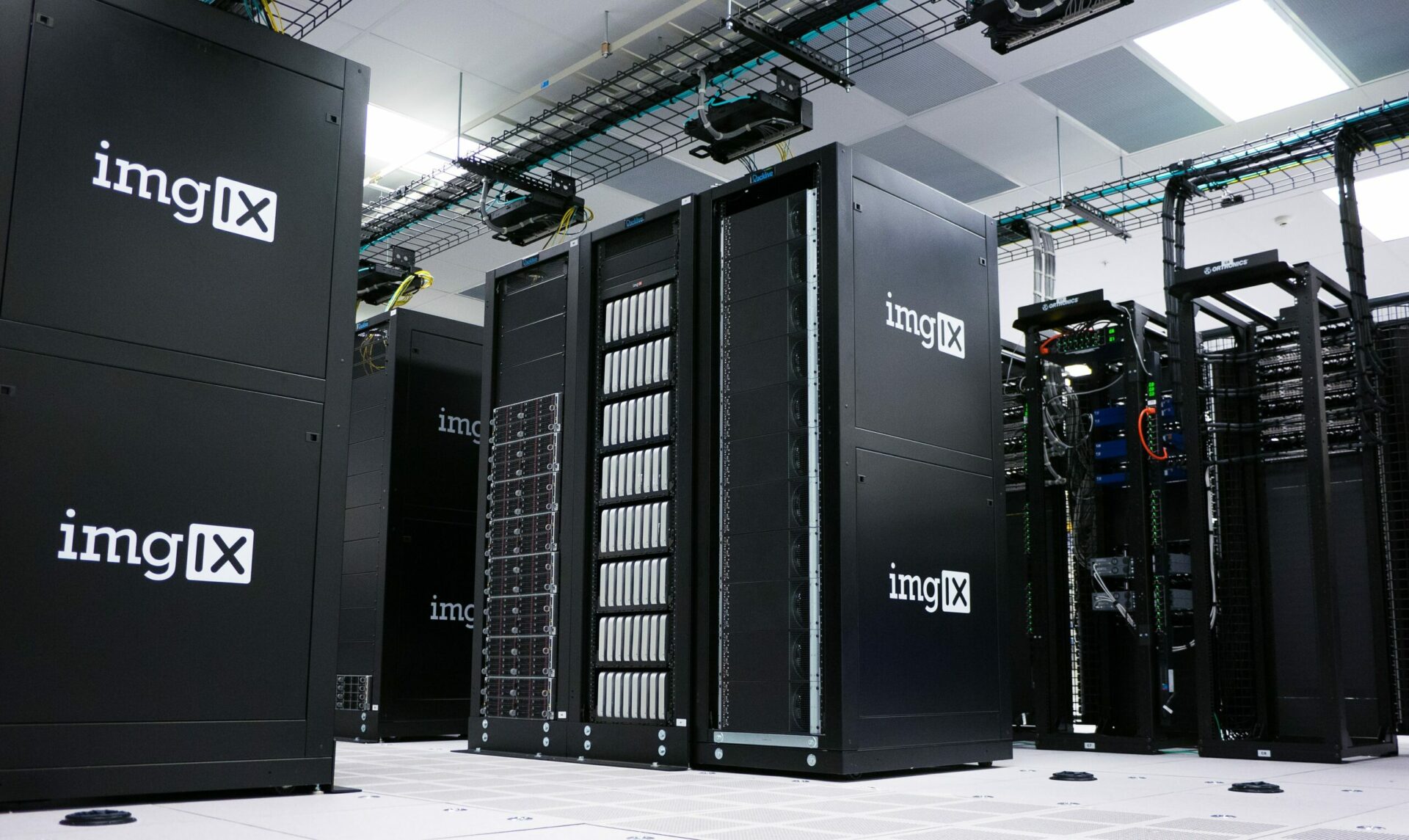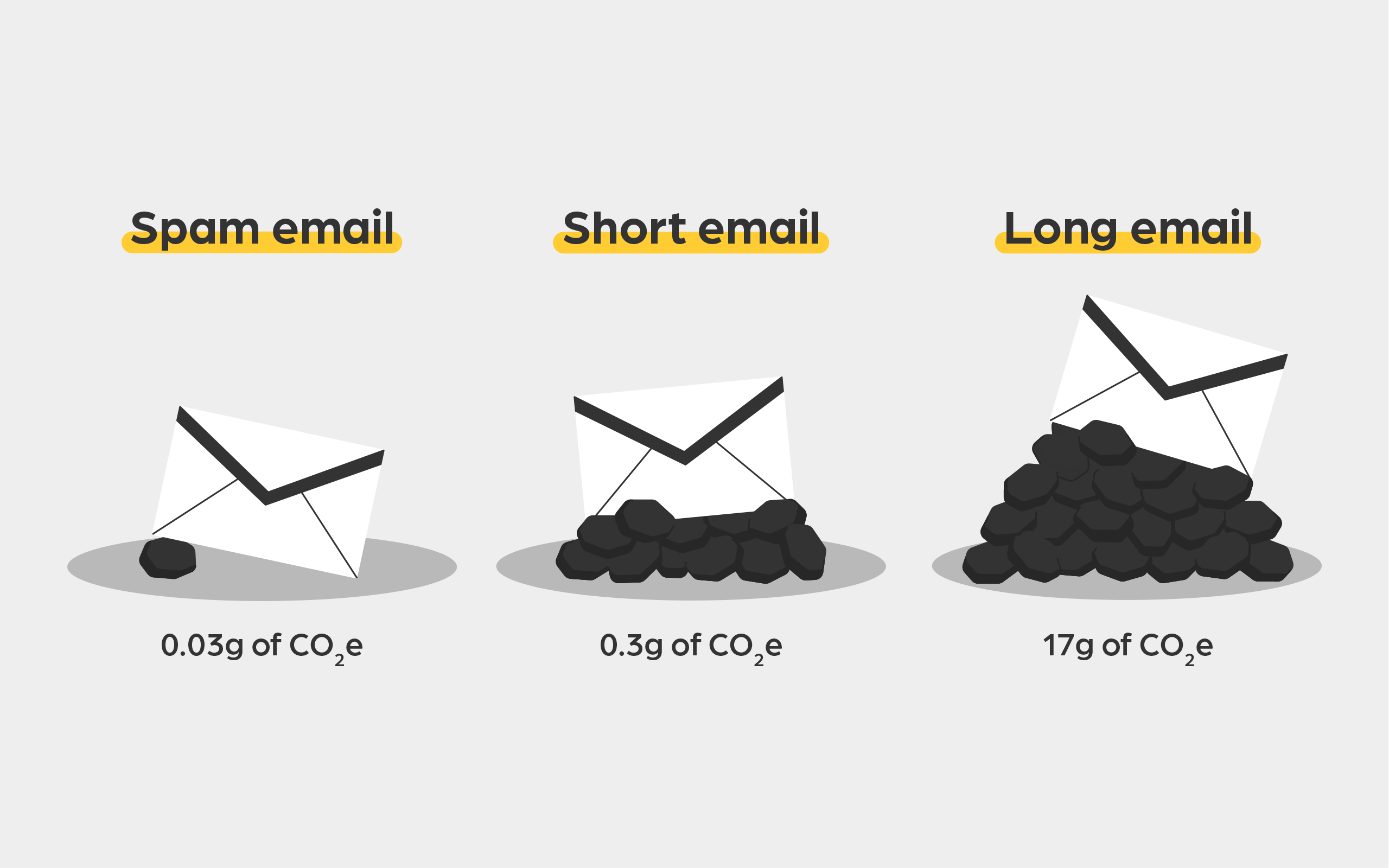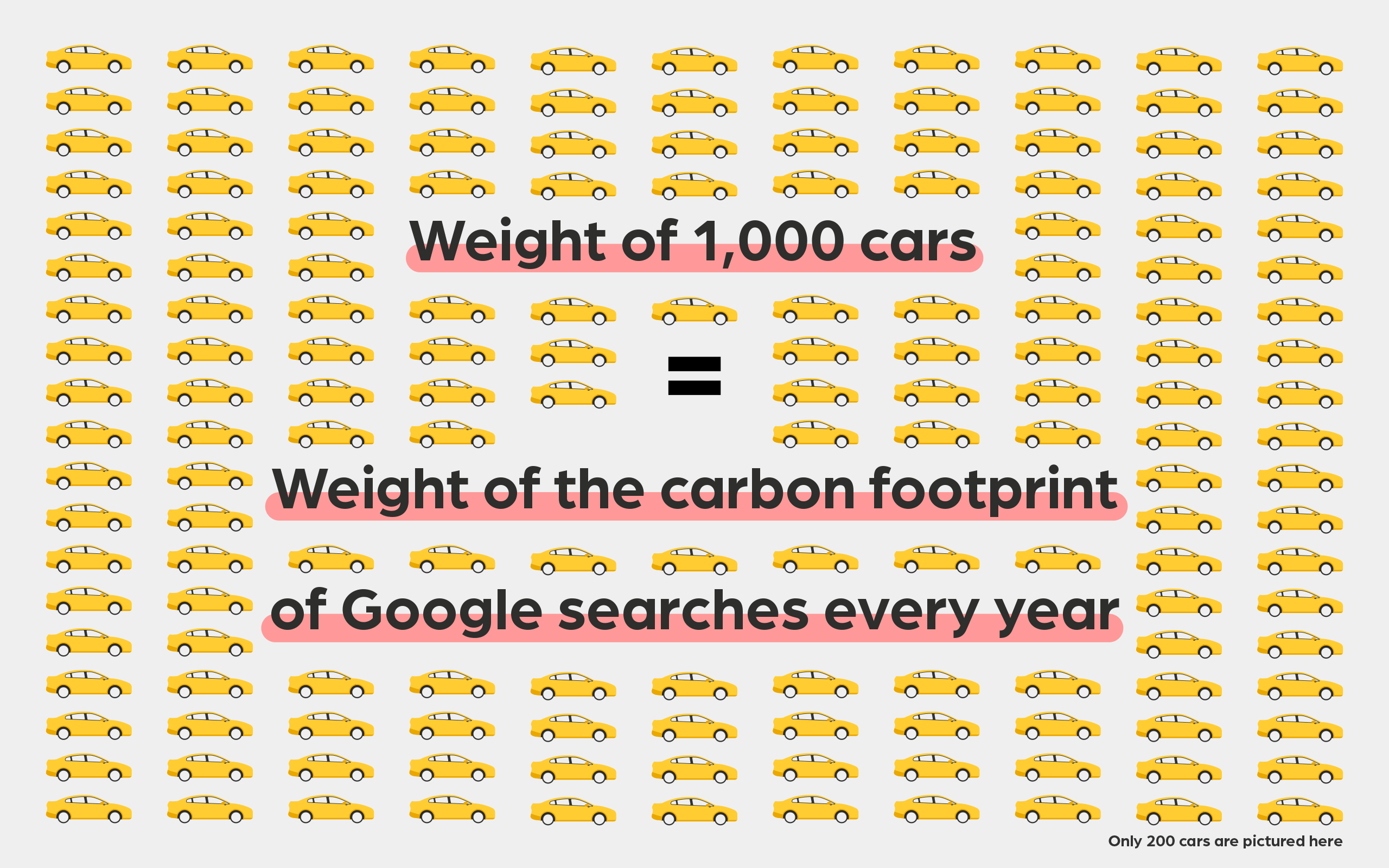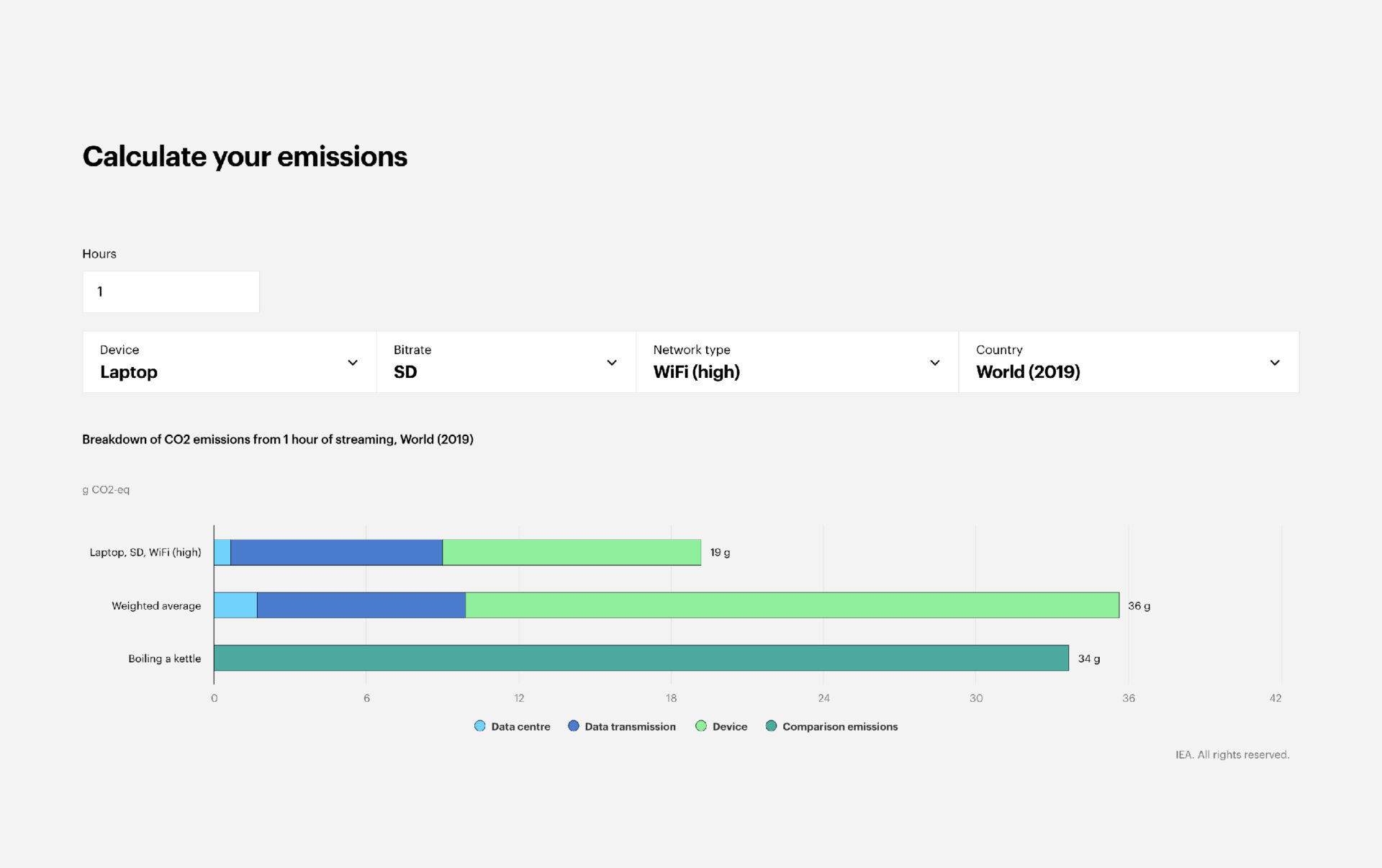Page content
Did you know that the internet has the same carbon footprint as the entire airline industry? About 2% of global greenhouse gas emissions are emitted by the internet every year. To put this into perspective, if the internet was a country, it would be the 7th largest CO2 emitter worldwide, right behind China, the US, India, Russia, Japan, and Germany.
But how? Isn’t the internet this magical, intangible thing that just exists? I hate to burst your bubble, but just take a look inside the basement of any big digital company. You’ll find rows and rows of huge computers running 24/7. They’re so big that employees use scooters to get around

These data centers don’t only use an immense amount of energy (mostly generated in coal-burning plants), but they also need to be constantly cooled down. And don’t make me even start on the insane amount of materials that are used to build these supercomputers. Or the transportation to get them to these data centers.
Isn’t it crazy how polluting is the internet and, yet, nobody talks about it? While a lot of people think twice- and rightfully- about flying somewhere, I don’t think anyone has ever had second thoughts about sending another email, listening to a new song on Spotify, or binging another series on Netflix. But every time you do this, you put a data center at work, and your device uses energy.
Is it possible to reduce our digital carbon footprint? Yes, and, as impact design experts, we’ve got your back! Keep reading to learn more about the internet’s footprint and the best practices individuals and companies can undertake in order to cut their emissions.
The math behind the internet’s carbon emissions
In his book How Bad Are Bananas? The Carbon Footprint of Everything, Mike Berners-Lee reports that the carbon footprint of an email can vary depending on what kind of email it is. It can range from 0,03g CO2e for spam or a short email to 17g for a long email. You are probably thinking “that’s not bad!” Well, in 2020 the 3.9 billion email users exchanged about 306.4 billion emails every day, how many grams of CO2 is that?

Let’s do some quick math. Thanks to Berners-Lee, we know that about half the emails sent are spam. Assuming that long and short emails are equally distributed, each of us emits about 491g of CO2e every day. This adds up to 179 kg every year and equals driving all the way from Brussels to Oslo with a regular car. I’d prefer that trip over sending all those emails, don’t you?
In the UK, it’s estimated that 64 million ‘thank you’ emails are sent every day. Sure, it’s nice to say thank you, but this adds up to 7,008 metric tons (!) of CO2e every year in the UK alone.
Let me Google that
We do it so much that it became a verb. But even ‘googling’ something has a carbon footprint. Google calculates that it comes out to about 8 grams of carbon daily, the equivalent of driving one car about one km per month. Of course, the problem is when you multiply those 8 grams by hundreds of millions of Google users. Every day there are more than 3.5 billion Google search inquiries worldwide which add up to 1750 metric tons of CO2e every year. To help you picture this, it’s the equivalent in weight of more than 1000 regular cars.

Are you still watching? Yes Netflix, I am …
To nobody’s surprise, the consumption of streaming media has increased rapidly. Steaming platforms’ subscriptions keep growing, while new streaming services are popping up everywhere. But how polluting is your binge-watching habit?
According to the International Energy Agency, watching Netflix for one hour produces around 36g of CO2e. So if you watched all 4 seasons of Stranger Things (about 30 hours) you emitted 800 grams of CO2e. Not too bad! But we all know it doesn’t stop at one show…
This number can also vary heavily depending on the type of device you’re streaming from. As you can imagine, a big flat-screen television uses way more energy than a small laptop.
The quality of the video also has an impact on carbon emissions. The higher the quality, the more energy is used, the higher the carbon emissions are. Did you know that in your Netflix account you can choose the quality of your video? By lowering your carbon emissions, you can also save money on your internet bill because you use fewer gigabytes.
Curious to know your carbon footprint? Check out this calculator.

4 tips to reduce your carbon footprint
1/ Take a look at your email habits
- Unsubscribe from newsletters you never read.
You can also turn off the email notifications of your social media accounts to limit the amount of useless emails in your inbox. You save 0.3g of CO2e for every newsletter you don’t receive. - Delete email addresses you don’t use anymore.
The emails this email address receives are never read but still emit CO2e. The storage of these useless emails also take up space in some data center which adds to your digital carbon footprint. - Put less people in CC or BCC.
Does your colleague really need to read that email or not? Save between 0,3g to 17g of CO2e for every person you don’t put in CC and limit the frustration amongst your colleagues because of useless email traffic. - Use small email attachments or links instead of big files.
You can go from 17g of CO2e for an email with attachments to 0,3g for an email with a simple link. Wetransfer (also a B Corp) is a wonderful tool to create links with attachments. - Clean out your inbox and cloud storage.
Try to back up only what’s essential because everything you save takes up space in a data center somewhere. - Avoid sending useless messages.
When you need to say something to a coworker it’s more eco-friendly (or just more friendly really) to walk over to their desk. Also, try to avoid forgetting email attachments and having to send yet another email.
2/ Use your browser better
- Use a search engine that helps the environment.
Gexsi is a certified B-corp search engine that uses its profits to support the Sustainable Development Goals. Ecosia invests 80% of its profit into planting trees. About every 45 searches, they plant a tree. You can even check how many trees they can plant with your own searches! - Switch to a green hosting provider.Following the inclusive design and accessibility guidelines, you can decrease your website’s environmental footprint while increasing inclusivity.
- Use an ad-blocker to limit the amount of ads you see.
It makes for a calmer online experience but also limits your carbon footprint by not showing often flashy and colourful ads and pop-ups that use a lot of bandwidth and energy. - Use bookmarks for websites you visit a lot.
A bookmark goes directly to the desired website instead of a search result page. This is more efficient and saves not only carbon but also some time. - Close tabs you’re not using.
- Listen to music without video.
If you’re listening to music, do so from a program that only plays music and no video. Yes, having Youtube on in another tab is wasteful.
3/ Your devices
- Reduce the brightness of your monitor.
Reducing your monitor brightness from 100% to 70% can save up to 20% of the energy the monitor uses. Most people don’t even notice the difference. - Think about your electronics.
The type and number of digital devices you own also add up to your carbon footprint. You can buy ethical electronics like Fairphone. Or, even better, don’t buy anything new at all. Secondhand and refurbished electronics are a great (and cost-saving) alternative to buying new devices. Also, remember to take good care of your devices to make them last longer.
4/ Switch to green energy
You might think you already have green energy, but how sure are you that your energy supplier doesn’t invest in gray or nuclear energy? Websites such as mijngroenestroom.be and The Energy Saving Trust can help you can find energy suppliers who offer green energy only.
How can businesses cut their emissions
Companies can reduce their digital carbon footprint significantly by changing a few things around:
Start a conversation about sustainability and the carbon footprint of your company with your team. You can help your employees to reduce their personal digital carbon footprint by handing them the tips above. You can also try to change the email culture by setting some guidelines or using an internal messaging system like Slack.
As mentioned in the tips above, switching to green energy and making your website more eco-friendly can cut a lot of the carbon emissions on your end. Did you know that the average website produces 1.76 grams of CO2e per page view? For a website with 10,000 monthly page views, that’s 211 kg CO2e per year. You could have a team building on a nice location and emit way less than this. For our client B Lab Europe, we designed an inspiring website to match the momentum of radical change following the sustainable web design and development guidelines. The result?
- An improved performance score from 86 to 95
- A greener web experience ranking cleaner than 59% of web pages, compared to its previous ranking stating it was dirtier than 94% dirtier of web pages
- A more accessible website with an accessibility score of 99
At Quest, we can do much more than making your website more environmentally friendly. Quest Impact Design Studio can support you and your business all the way through your journey toward a more sustainable future. Need to scale your impact? Interested in accelerating positive change? Reach out to our team for a free discovery call!
A low-carbon website for your business?
Our team of UX, UI designers and developers know what it takes to create inclusive websites with a low carbon footprint. Want to join our client community, just like a.o. B lab Europe, Fashion for Good and Organic Cotton Accelerator?




